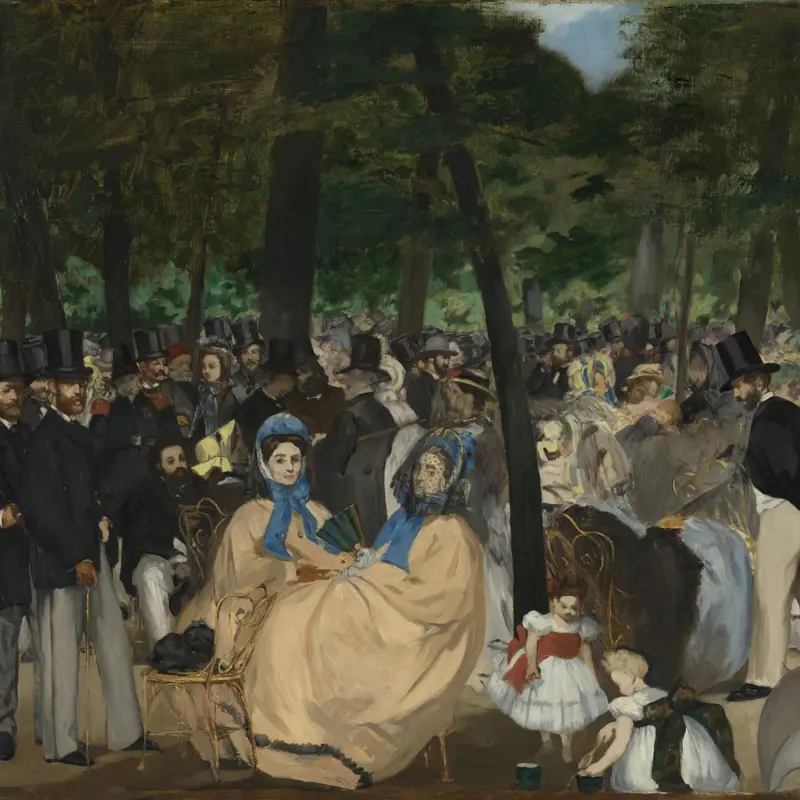Edouard Manet, 'The Execution of Maximilian', about 1867-8
About the work
Overview
Ferdinand Maximilian was enthroned as a puppet emperor of Mexico in 1864 with the support of Emperor Napoleon III of France. However, Napoleon III reneged on his military support. Captured in May 1867 by nationalist Mexican and Republican forces, Maximilian and two of his generals were executed by firing squad on 19 June that year.
Manet was outraged by the death of Maximilian, who was widely viewed as a victim of Napoleon III’s political ambition and incompetence, and decided the execution merited artistic treatment on an epic scale. This damaged painting is the second of four versions he painted between 1867 and 1868. He probably abandoned this version because of discrepancies in the size of the figures. A photograph taken in 1883 shows the left-hand section of the canvas had been removed and the picture damaged elsewhere. After Manet’s death, his family cut up the canvas and sold individual fragments separately. Surviving fragments were acquired by Degas and bought by the National Gallery in 1918. They were finally combined on one canvas in the late 1970s.
Key facts
Details
- Full title
- The Execution of Maximilian
- Artist
- Edouard Manet
- Artist dates
- 1832 - 1883
- Date made
- about 1867-8
- Medium and support
- oil on canvas
- Dimensions
- 193 × 284 cm
- Acquisition credit
- Bought, 1918
- Inventory number
- NG3294
- Location
- Room 41
- Collection
- Main Collection
- Frame
- 20th-century Replica Frame
Provenance
Additional information
Text extracted from the ‘Provenance’ section of the catalogue entry in Martin Davies, with additions and some revisions by Cecil Gould, ‘National Gallery Catalogues: French School: Early 19th Century, Impressionists, Post-Impressionists, etc.’, London 1970; for further information, see the full catalogue entry.
Exhibition history
-
2014The National Gallery Masterpiece Tour: Manet's 'The Execution of Maximilian'The Beaney17 January 2014 - 16 March 2014The Bowes Museum22 March 2014 - 18 May 2014Mead Gallery, University of Warwick4 October 2014 - 6 December 2014
-
2016Painters' Paintings: From Freud to Van DyckThe National Gallery (London)23 June 2016 - 4 September 2016
-
2023Manet / DegasMusée d'Orsay27 March 2023 - 23 July 2023The Metropolitan Museum of Art18 September 2023 - 7 January 2024
Bibliography
-
1902T. Duret, Histoire de Edouard Manet et de son oeuvre, Paris 1902
-
1910M. Liebermann, 'Ein Beitrag zur Arbeitsweise Manets', Kunst und Künstler, VIII, 1910, pp. 483ff
-
1912J. Meier-Graefe, Edouard Manet, Munich 1912
-
1918Galerie Georges Petit, Catalogue des tableaux modernes et anciens, aquarelles, pastels, dessins, par Bartholomé … composant la collection de Edgar Degas, Paris, 26 March 1918 - 27 March 1918
-
1926E. Moreau-Nélaton, Manet raconté par lui-même, 2 vols, Paris 1926
-
1926C. Bell, 'Les tableaux français modernes à la Galerie Tate et à la Galerie Nationale de Londres', L'Amour de l'art, 1926
-
1931A. Tabarant, Manet: Histoire catalographique, Paris 1931
-
1932P. Jamot, G. Wildenstein and M.-L. Bataille, Manet, Paris 1932
-
1936C.J. Holmes, Self and Partners (mostly Self), London 1936
-
1936A. Vollard, Souvenirs d'un marchand de tableaux, Paris 1936
-
1936A. Vollard, 'Quand on dépeçait les Manet', Candide, 1936
-
1942National Gallery, Nineteenth Century French Paintings, London 1942
-
1946Martin Davies, National Gallery Catalogues: French School, London 1946
-
1947M. Florisoone, Manet, Monaco 1947
-
1947A. Tabarant, Manet et ses oeuvres, Paris 1947
-
1948K. Martin, Der Kunstbrief. Die Erscheinung Kaiser Maximilians von Mexico von Edouard Manet, Berlin 1948
-
1951J.C. Sloane, 'Manet and History', Art Quarterly, XIV, 1951, pp. 92-106
-
1954N.G. Sandblad, Manet: Three Studies in Artistic Conception, Lund 1954
-
1956M. Davies, 'Recent Manet Literature', The Burlington Magazine, XCVIII/638, 1956, pp. 169-71
-
1957Martin Davies, National Gallery Catalogues: French School, 2nd edn (revised), London 1957
-
1965J. Kühn, Das Ende des maximilianischen Kaiserreichs in Mexico. Berichte des königlich preußischen Ministerresidenten Anton von Magnus an Bismarck, 1866-1867, Göttingen 1965
-
1966G.H. Hamilton, 'Is Manet Still "Modern"?', Art News Annual, XXXI, 1966, pp. 121-3
-
1968A. Scharf, Art and Photography, London 1968
-
1970Davies, Martin, and Cecil Gould, National Gallery Catalogues: French School: Early 19th Century, Impressionists, Post-Impressionists etc., London 1970
-
1970S. Orienti and P. Pool, The Complete Paintings of Manet, London 1970
-
1972T. Schlotterback, 'Manet's "L'Exécution de Maximilien"', in G. Rózsa (ed.), Evolution générale et développements régionaux en histoire de l'art: Actes du XXIIe Congrès International d'Histoire de l'Art, 1969, Budapest 1972, pp. 785-98
-
1973A. Boime, 'New Light on Manet's Execution of Maximilian', Art Quarterly, XXXVI, 1973, pp. 172-208
-
1975D. Rouart and D. Wildenstein, Edouard Manet: Catalogue raisonné, Lausanne 1975
-
1977A.C. Hanson, Manet and the Modern Tradition, New Haven 1977
-
1977A. Griffiths, 'Correspondence: Execution of Maximilian', The Burlington Magazine, CXIX/896, 1977, p. 777
-
1977L. Johnson, 'A New Source for Manet's "Execution of Maximilian"', The Burlington Magazine, CXIX/893, 1977, pp. 560-4
-
1979J. Mills and R. White, 'Analyses of Paint Media', National Gallery Technical Bulletin, III, 1979, pp. 66-7
-
1981P.M. Jones et al., Edouard Manet and the Execution of Maximilian (exh. cat. Bell Gallery, Brown University, 21 February - 22 March 1981), Providence 1981
-
1982J. Richardson, Manet, Oxford 1982
-
1983D. Sutton, 'Edouard Manet: The Artist as Dandy', Apollo, 1983, pp. 330-41
-
1983M. Wilson, Manet at Work: An Exhibition to Mark the Centenary of the Death of Edouard Manet, 1832-1883 (exh. cat. The National Gallery, London, 10 August - 9 October 1983), London 1983
-
1983J. Wilson-Bareau, 'Documents Relating to the Maximilian Affair', in Manet 1832-1883, New York 1983, pp. 531-4
-
1984K. Flint (ed.), Impressionists in England: The Critical Reception, London 1984
-
1984A. Fonsmark, 'Manet og Kejser Maximilians henrettelse: Om skitsen i Ny Carlsberg Glyptotek', Meddelelser fra Ny Carlsberg Glyptotek, XL, 1984, pp. 63-84
-
1986J. Wilson-Bareau, The Hidden Face of Manet: An Investigation of the Artist's Working Processes (exh. cat. The Courtauld Gallery, 23 April - 15 June 1986), London 1986
-
1987J. Manet, Growing Up with the Impressionists. The Diary of Julie Manet, eds R. de Boland Roberts and J. Roberts, London 1987
-
1989E. Darragon, Manet, Paris 1989
-
1989A. Roquebert, 'Degas collectionneur', in Degas Inédit, Actes du Colloque Degas, Musée d'Orsay (1988), Paris 1989, pp. 65-85
-
1992L. Stevenson, Manet, London 1992
-
1992M. Fath and S. Germer, Edouard Manet. Augenblicke der Geschichte, (exh. cat. Kunsthalle Mannheim, 18 November 1992 - 17 January 1993), Munich 1992
-
1992J. Wilson-Bareau et al., Manet: The Execution of Maximilian: Painting, Politics and Censorship (exh. cat. The National Gallery, London, 1 July - 27 September 1992), London 1992
-
1993O. Bätschmann, Edouard Manet: Der Tod des Maximilian, Frankfurt am Main 1993
-
1993D. Johnson and J. Wilson-Bareau, Manet, Maximiliano y México, Polanco, México 1993
-
1993R. White and J. Pilc, 'Analyses of Paint Media', National Gallery Technical Bulletin, XIV, 1993, pp. 86-94
-
1994Manet, Maximiliano y México, n.p. 1994
-
1994A. Thomas, An Illustrated Dictionary of Narrative Painting, London 1994
-
1994A. Kuhn-Wengenmayr, 'Fünf Zeichnungen von Edouard Manet nach Benozzo Gozzoli', Mitteilungen des Kunsthistorischen Institutes in Florenz, XXXVIII/1, 1994, pp. 165-82
-
1996A. Dumas, Degas as a Collector, London 1996
-
1996M. Fried, Manet's Modernism, or the Face of Painting in the 1860s, Chicago 1996
-
1996A. Emberton, 'Keynes and the Degas Sale', History Today, 1996
-
1996V. Sellin, 'Die Bestrafung des Usurpators: Edouard Manets "Erschießung des Kaisers Maximilian von Mexiko"', Pantheon, LIV, 1996, pp. 108-22
-
1997P. Smith, 'Review: Manet Bits', Art History, 1997, pp. 477ff
-
1997A. Dumas et al., The Private Collection of Edgar Degas (exh. cat. Metropolitan Museum of Art, 1 October 1997 - 11 January 1998), New York 1997
-
1998H. Loyrette, 'Degas's Collection', The Burlington Magazine, CXL/1145, 1998, pp. 551-8
-
2000R. Morphet et al., Encounters: New Art from Old (exh. cat. The National Gallery, 14 June - 17 September 2000), London 2000
-
2001
C. Baker and T. Henry, The National Gallery: Complete Illustrated Catalogue, London 2001
-
2002M. Nonne, 'Les droits douaniers américains et les marchands de tableaux français au XIXe siècle', Revue du Musée d'Orsay, XLVIII/14, 2002, pp. 102-8
-
2003E. Langmuir, Narrative, London 2003
-
2003M.B. Mena Marqués (ed.), Manet en el Prado (exh. cat. Museo Nacional del Prado, 13 October 2003 - 11 January 2004), Madrid 2003
-
2005J. Meyers, 'Degas and Manet: A Study in Friendship', Apollo, CLXI, 2005, pp. 56-63
-
2006K. Ibsen, 'Spectacle and Spectator in Edouard Manet's "Execution of Maximilian"', Oxford Art Journal, XXIX/2, 2006, pp. 213-26
-
2006J. Elderfield, Manet and the Execution of Maximilian (exh. cat. Museum of Modern Art, 5 November 2006 - 29 January 2007), New York 2006
About this record
If you know more about this work or have spotted an error, please contact us. Please note that exhibition histories are listed from 2009 onwards. Bibliographies may not be complete; more comprehensive information is available in the National Gallery Library.






